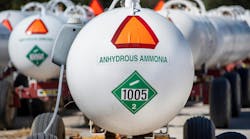The interests of energy consumers are under “direct assault” by the US government, but the attack started long before President Obama's administration, according to Bob Tippee, editor of Oil & Gas Journal.
“We got here because of a determination in how the United States thinks about energy,” he said. “This started before the administration of President Obama. It even started before the takeover of Congress by the Democrats. We have heard the term ‘energy independence.’ We heard that for many years, and the problem with that is it doesn't actually exist. We're in an energy interdependent world. But we hear ‘energy independence’ to promote any type of policy. Former President George Bush gave that fantasy in his State of the Union address in 2003.”
Tippee was one of three presenters appearing at the ILTA Conference's seminar, “The New Political Landscape: What's in Store for the Terminal Industry?” He gave the “National Viewpoint.” Other presenters were Jay McKeeman, vice-president of government relations and communications for the California Independent Oil Marketers Association, with “The California Petri Dish — Breeding Regulatory Change”; and James E Benton, executive director of the New Jersey Petroleum Council, with “New Jersey's Aggressive Regulatory Approach.”
Tippee also disagrees with these perceptions:
-
“Energy is too important to leave to market” — which was embodied in the Energy Policy Act of 2005 (EPACT).
“I believe the reverse: it's too important not to leave to market,” Tippee said. “That proposition was hailed as triumph of bipartisanship but was in fact a grab bag of goodies for every energy supplier. EPACT solidified the idea that government is better at fuel choice than consumers are. And the highlight was the mandate for ethanol in gasoline that was implemented.”
-
“The United States is addicted to oil,” which former President Bush declared in his State of the Union address in 2006.
“Since then, we have heard that along with ‘energy independence’ as a brand for policy initiatives of all sorts. We'd heard there was not enough conservation and there aren't enough renewables. That would derail any supply moves that should have moved forward. The formula became enshrined in law in the Energy Independence and Security Act of 2007. Congress toughened fuel economy standards for new vehicles in the United States and also tremendously increased the mandate for ethanol. The mandate makes no sense and may be economically unfeasible.”
-
“We need to “end the tyranny of oil,” which President Obama said at the Department of Energy on February 5.
“The new President seemed to want to one-up his predecessor and told the group that we will begin to end the tyranny of oil in our time. So we've gone from addiction to tyranny.”
Tippee criticized the Obama energy team as being very anti-oil, with the liberalization of committees coming when Rep Henry Waxman (D-CA) displaced Rep John Dingell (D-MI) as chair of the House Energy and Commerce Committee and Rep Ed Markey (D-MA) displaced Rick Boucher (D-VA) as chair of the Energy and Air Quality Subcommittee.
“Suffice it to say, this is not a cheerleading squad for the oil, gas, and coal squad,” Tippee said. “As a result, we have a framework for political directions of subordinating the oil and gas supply to environmental pressures in the area of land access. We have a push for increasing the taxation of oil and gas to pay for other reforms, and limiting greenhouse gas emissions with the cap-and-trade scheme.
“Land access is important to oil and gas because so much of unexplored resources in the United States is on federal land. That has been shrinking considerably since Obama took over.”
In March, Congress enacted and President Obama signed the Omnibus Public Land Management Act of 2009, which combined more than 160 bills and dictated that two million acres of federal land be made into wilderness. Tippee said it subjects 26 million acres to tighter control under the National Landscape Conservation System.
“Land access is a huge problem,” he said.
He said the American Recovery and Reinvestment Act, which became law February 2, commits to 10-year spending of $43 billion on green energy and to tax relief worth $22 billion for green energy.
“That's supposed to create green jobs,” he said. “The problem with green jobs is that when you're subsidizing energy and you're forcing high-cost energy against low-cost energy, you lower the profitability of the economy. And when you do that, you're going to have job losses. How do we pay for all of this? President Obama proposed a budget that I call an ‘off-oil budget’ or ‘get-out-of-town budget.’ It raises costs for the oil and gas industry by the Superfund tax. Congress dealt a major blow to independent producers, the people who drill most of the wells in the United States. I've heard estimates of 30%-50% investment reductions if this becomes law.
“In green booklets, there was wording that sent a shudder through the oil and gas market. The Administration's thinking: ‘We are going to use less oil and gas so we can use more renewable energy, and we're producing too much oil and gas now, and that is bad for our security.’ That is a totally new take.”
McKeeman said California has assumed the mantle of leader in the development of Global Climate Change, or Greenhouse Gas regulations. The state passed landmark legislation in 2008, with AB 32 mandating the continuing decrease of carbon emissions through 2050.
“In California, they say innovation is good,” he said. “But it also infuses the population with the expectation that we shouldn't wait for other people to try things out and see if they work, and the need to be on that leading edge of innovation. We have a governor who perhaps has spent too many days at the Kennedy compound. The environment is where he's going to leave his legacy. We have a highly Democrat legislature and a governor who is very soft or unwilling to take the lead on environmental issues.”
He said this has created a rapid downward trend, with the result being “death to petroleum.”
“By 2050, there will be very little gas and diesel left in the fuel mix,” he said. “The fuel mix is basically hydrogen and electricity to get to the carbon-reduction levels in the legislature. I don't see it being solved in any reasonable manner.”
CARB Standard
McKeeman said the California Air Resources Board (CARB) in April adopted a Low Carbon Fuel Standard (LCFS) that essentially puts the burden of compliance on major suppliers and terminals for blended fuel, leading to controversial “field to wheels” calculations.
“This is where you determine the carbon footprint of fuel by looking at the entire carbon history,” he said. “The determination by the resources board was that, in essence, any renewable fuel that came from a food source is not carbon friendly, due to land use and planting pressures put on tropical countries to convert rainforest to crops. So esoteric fuels such as biomass ethanol and algae biodiesel will be the ‘favored children.’
“These fuels are still on the lab bench, with little expectation that they will be in sufficient production by 2014, when requirements begin to kick in, in earnest. The California Independent Oil Marketers Association's (CIOMA) concern is, will these fuels be ‘market-ready’ when they become available?”
To CIOMA, “market-ready” means that all third-party/manufacturer/government certifications and approvals have been completed (pipelines, terminals, cargo tanks, bulk tanks, hoses and blending equipment, UST systems, dispensers and hardware, and consumer notifications and labeling).
“There was no provision in the LCFS for a ‘market-ready’ clearing house,” he said. “There is saber-rattling and a possible lawsuit challenging this rule. A carbon credit purchase is required if you can't meet the annual low carbon fuel distribution requirements. It may act as a template for EPA regulation.”
He said there's more: The legislature delegated taxing authority to CARB in AB 32. CARB has estimated that it will need $50 million a year to implement AB 32 and is proposing fees on utilities and fuels to cover the expenses.
“CARB does not want to share how it came to that number with the regulated community,” he said. “A lawsuit has been filed. Pipeline pumps are a possible target for a lower carbon footprint.”
Aggressive Approach
Benton said New Jersey has the location, population, navigation access, sophisticated infrastructure, and demand as a supplier for oil and gas — including four refineries, the Colonial Pipeline terminus, the largest product storage in the nation, and the largest East Coast crude oil port (Delaware River).
Unfortunately, the state's budget woes have gone from “bad to worse to truly awful.”
There is a $1.2 billion revenue gap, including $450 million from surplus, $450 million from deferred spending, $150 million from reduced pension payment, and $150 million from cuts from state departments.
“It has deteriorated as revenue streams have gone down,” Benton said. “It is clearly a challenge to balance the budget. Our legislature is really putting on Band-aids as best they can.
“Tension remains, and it is a continuing significant issue. If municipalities are challenged to make up local revenue, they will look at schemes and policy initiatives they can take to raise revenue.”
He said there is a Gloucester County Initiative for a local petroleum storage tax.
“Candidly and somewhat chillingly, they look around and say, ‘There's a storage tax there, and it must have some value there,’ ” he said.
He said the final reasonably available control technology (RACT) requirement “will impact all aspects of your operations.” Rules provide for additional time for compliance. By September 16, companies must show compliance with no visible gaps in fitting. By December 1, they must identify controls in roof landings. By May 1, 2010, emissions from tank cleaning and degassing must be controlled and permitted.
For low sulfur heating oil, there is a proposal for particulate emission levels of 15 parts per million (PPM), and a response from the industry of 50 PPM.
“You can anticipate that the state of New Jersey will come out with a proposal that calls for 15 PPM,” he said. “Heating oil in the Northeast is a serious issue because it does provide warmth, comfort, and safety. New Jersey doesn't want California to take all of the lead, so now there's an effort by Northeast states to try to jump in on California fuel. Clearly if California wants to be the template for regulation, New Jersey wants a big piece of it. They've already signed a joint letter to other Northeast states, saying they will promulgate it.”








